- Gongylophis conicus
Taxobox
name = "Gongylophis conicus"

image_caption =
regnum =Animalia
phylum =Chordata
subphylum =Vertebrata
classis =Reptilia
ordo =Squamata
subordo =Serpentes
familia =Boidae
subfamilia =Erycinae
genus = "Gongylophis "
species = "G. conicus"
binomial = "Gongylophis conicus"
binomial_authority = (Schneider, 1801)
synonyms = * ["Boa"] "Conica" - Schneider, 1801
* "Boa Viperina" - Shaw, 1802
* "Boa ornata" - Daudin, 1803
* "Erix Bengalensis" - Guerin, 1830
* ["Tortrix"] "eryx bengalensis" - Schlegel, 1837
* "Gongylophis conicus" - Wagler, 1842
* "Eryx conicus" - A.M.C. Duméril & Bibron, 1844
* "Eryx conicus" var. "laevis" - Peters, 1869
* "Gongylophis conicus" - Boulenger, 1890
* "Eryx conicus" - Boulenger, 1893
* "Eryx conicus brevis" - Deraniyagala, 1951
* "Eryx conicus conicus" - Rajendran, 1967
* "Eryx conicus gansi" - Rajendran "In" St. Xavier's College Magazine, 1971
* "Gongylophis" ("Gongylophis") "conicus" - Tokar, 1989
* ["Eryx"] "conicus" - Kluge, 1993
* "E" ["ryx"] . "conicus" - Szyndlar & Schleich, 1994
* "Gongylophis" [("Gongylophis")] "conicus" - Tokar, 1995McDiarmid RW, Campbell JA, Touré T. 1999. Snake Species of the World: A Taxonomic and Geographic Reference, vol. 1. Herpetologists' League. 511 pp. ISBN 1-893777-00-6 (series). ISBN 1-893777-01-4 (volume).]:"Common names: rough-scaled sand boa,Mehrtens JM. 1987. Living Snakes of the World in Color. New York: Sterling Publishers. 480 pp. ISBN 0-8069-6460-X.] rough-tailed sand boa.""Gongylophis conicus" is a non-venomous boa
species found inIndia ,Pakistan andSri Lanka . Nosubspecies are currently recognized. ITIS|ID=634814|taxon="Gongylophis conicus"|year=2008|date=8 July]Description
Total length 3 feet 3 inches (99 cm); tail 3 inches (76 mm). Anterior maxillary and mandibulary teeth a little longer than the posterior. Head covered with small scales. The eye is very small with vertical pupil. Scales very small, smooth or keeled. Tail very short and blunt, not or but very slightly prehensile.
The
rostral scale is large and broad with angular horizontal edge. Behind the rostral there are two pairs of small scales. Interorbitals: 6 to 9. Circumorbitals: 10 or 11. The eye is separated from the labials by one or two rows of scales.Supralabial scales : 10 to 12.Dorsal scales slightly keeled, in 51 to 65 rows.Ventral scales : 194-210. Theanal scale is single.Subcaudals : 26-36.The anterior scales are only feebly keeled, but these increase in size posteriorly to the point that they become so heavily keeled that it can make a squirming specimen really painful to handle. This also makes it look as if the front and rear ends belong to markedly different animals.Ditmars RL. 1933. Reptiles of the World. Revised Edition. The MacMillan Company. 329 pp. 89 plates.]
The color pattern is sandy grey, reddish, or pale brown above, uniform or with more or less distinct blackish transverse bands, these bands are usually distinct on the tail. The belly brown, or spotted with blackish. Juveniles are often a pale coral-red.
In
India it can be mistaken at first glance for either the Indian python, "Python m. molurus", or the deadly Russell's viper, "Daboia russelii".Active at night, it feeds on worms and small mammals.
Geographic range
Found in eastern
Pakistan ,India south of about 30°N latitude, and in the northern arid region ofSri Lanka . The type locality given is "India orientali."Habitat
Sandy tracts of central and southern India, the Punjab, Kutch and Sind.
ee also
*
List of erycine species and subspecies
*
*References
Further reading
* Boulenger GA. 1890. Fauna of British India. Reptilia and Batrachia.
* Jones C. 2004. Sandboas. Reptilia 9 (3): 20-30.
* Tokar AA. 1995. Taxonomic revision of the genus "Gongylophis" Wagler 1830: "G. conicus" (Schneider 1801) and "G. muelleri" Boulenger 1892 (Serpentes Boidae). TROPICAL ZOOLOGY 8 (2): 347-360.
* Whitaker R, Captain A. 2004. Snakes of India. Draco Books, 500 pp.External links
*
Wikimedia Foundation. 2010.
